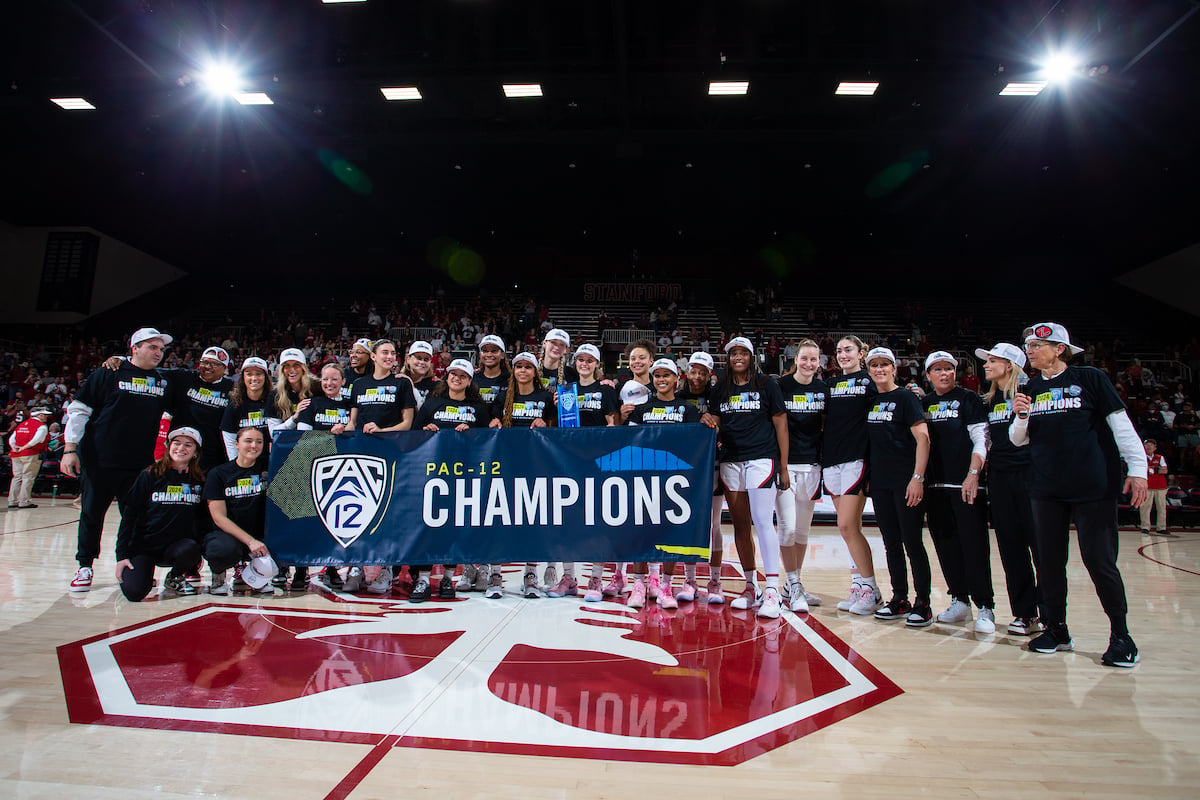With the NCAA tournament soon approaching, No. 4 Stanford women’s basketball (24-4, 13-3 Pac-12) will make its 36th consecutive appearance in March Madness. Participating in the tournament is nothing new for the Cardinal, but it may hold more significance this season.
After receiving a share of the Pac-12 regular season title and earning a No. 1 seed, the Cardinal were eliminated in the second round by No. 8 seed Ole Miss. The last time head coach Tara VanDerveer and her team were eliminated that early in the tournament was 2007, when they lost to Florida State in the second round.
With three seniors graduating last season to pursue professional careers and three more transferring, the departing talent created concerns about whether Stanford could repeat the success of previous seasons.
However, with one week of in-conference play remaining, Stanford has clinched at least a share of the last Pac-12 championship ever — they are likely to finish the regular season a top-five team in the nation.
With a dynamic front-court duo, senior forward Cameron Brink and junior forward Kiki Iriafen, spearheading the scoring load, the team is a serious contender for another championship.
Questions still remain, though, about the team’s ability to get offensive production from its guards and perform well without star forward Brink on the court.
Here are three keys for Stanford to find the gold at the end of the rainbow — or a deep March Madness run.
Three-point efficiency
Regardless of the matchup, it will be important for Stanford guards to make their three-point shots at a respectable clip. While this is important for any offense, especially in modern five-out basketball, three-point shooting will be especially significant for the Cardinal.
Good shooting will prevent help-defense on the strong side from crashing down too hard on Iriafen or Brink at the elbows, which will allow them to utilize their face-up games much more effectively. The Cardinal struggle the most when Brink and Iriafen are having an off-night, and giving them the proper space to operate in the pinch post is key to prevent that from occurring.
Shooting also opens up the opportunity for backdoor cuts from guards, if defenders play shooters tight.
While shooting a good percentage from the arc is a bonus for any team, it will be particularly key for Stanford to operate at their best offensively.
Contain dynamic guards
ESPN’s pre-tournament mock bracket projects Stanford at No. 1 in the region, above regional opponents Iowa, Colorado, Notre Dame and Gonzaga. If the Cardinal were to face this bracket in the tournament, they will likely see freshman guard Hannah Hidalgo and Notre Dame in the Sweet Sixteen, followed by Caitlin Clark and the Hawkeyes in the Elite Eight.
Many Stanford fans will recall the USC game on Feb. 2, where star freshman guard JuJu Watkins tallied 51 points in a 67-58 upset over the Cardinal. There isn’t another guard in the country that has the combination of size, speed and shooting that Watkins possesses. As a result, it is hard to extrapolate a trend from USC’s game against Stanford on Feb. 2.
But if Stanford must play in a bracket with such dynamic guard play, it will be interesting to see how VanDerveer switches up her defensive scheme after facing Watkins earlier this month.
Both Hidalgo and Clark are more than capable of exploding for 40 points during any given game, and forcing the ball out of their hands earlier in the possession could help the Cardinal in a hypothetical matchup. This could happen through an aggressive ballscreen defense that involves hard hedging or blitzing the ballscreen.
Star players stay away from foul trouble
After Stanford’s loss to Arizona on Friday, it’s clear that the Cardinal are a much different team with Brink on the court. The six-foot-four forward is having an All-American season, averaging 17.7 points, 11.3 rebounds and 3.7 blocks per game. While Brink is certainly a force offensively, her presence in the paint defensively changes the way teams run their offense.
However, throughout her time at Stanford, Brink has struggled with foul trouble, often limiting her effectiveness at pivotal moments during games. For Stanford to maximize its potential, Brink will need to avoid cheap fouls early in the game. The same goes for the six-foot-three Iriafen, who leads the Cardinal in scoring with 18.7 points per game. Having both Iriafen and Brink on the court creates an overwhelming presence in the paint for opponents.
Their ability to control the boards, alter shots and get easy paint baskets is the engine that makes Stanford go. If both are able to play aggressive yet disciplined, Stanford’s chances to return to the Final Four will increase exponentially.
